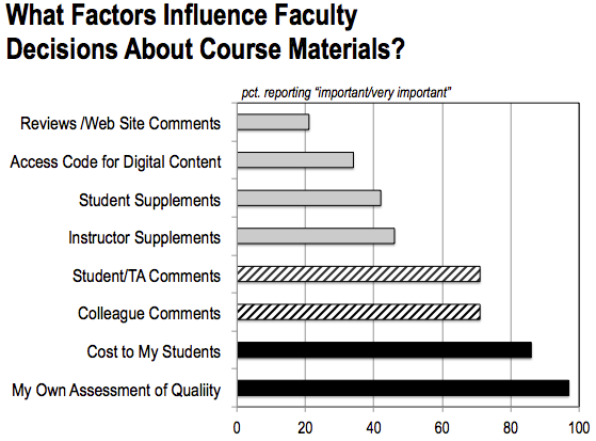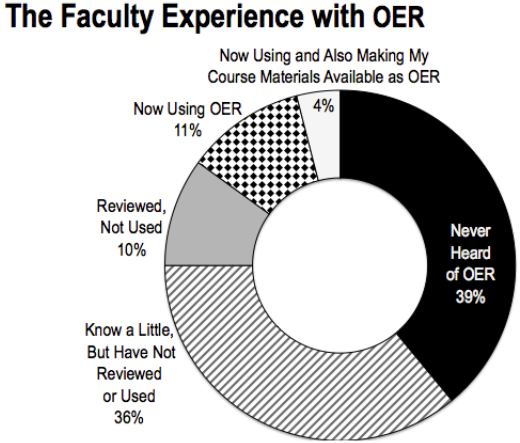You have /5 articles left.
Sign up for a free account or log in.
Quality, cost, reputation -- in that order. Those are the top three factors that influence how faculty members pick which textbooks and course materials they assign, according to the results of a survey of faculty at two- and four-year institutions.
Virtually every faculty member surveyed (97.1 percent) for “Going Digital,” a report being presented today at the Independent College Bookstore Association retail conference in Orlando, Fla., said their own assessment of the quality of a textbook is an important or a very important factor influencing their course material selection process, followed by the cost (86.3 percent) and a near tie between comments from colleagues (71.2 percent) and students or teaching assistants (71.1 percent). Less than one-third of respondents (31.6 percent) said the availability of digital supplements played an important role in that process.
But responses to the central question of “Going Digital” suggest faculty members are in no rush to get rid of physical textbooks. Only 15.1 percent of faculty members said they used primarily digital materials last fall. Of those who are still using print, 7.4 percent said they intend to make the switch this fall, while 27.3 percent and 17.1 percent see themselves switching in the next three or five years, respectively. Nearly one-quarter of all respondents (24 percent) said they will never primarily use digital materials in their courses.
Open educational resources, meanwhile, remain unknown or unused by all but 15 percent of faculty members, raising further questions about the lack of awareness about free or inexpensive alternatives to commercial textbooks.
Kenneth C. Green, who conducted the survey on behalf of the ICBA, said publishers and course material providers that are investing in and counting on a transition from print to digital should not reconsider their priorities. “The issue is not a matter of if,” Green said in an interview. “It’s a matter of how.”
Faculty members gave plenty of reasons for why they prefer physical textbooks. A majority of those surveyed said digital course materials are more difficult to use (59 percent), offer lower quality (80.9 percent) and don’t provide any academic benefits compared to textbooks (72.3 percent).
But faculty members also indicated that there are issues beyond their control that are holding back widespread use of digital course materials. More than one-quarter of faculty members (27 percent) said their students don’t have easy access to laptops and tablets -- devices they would use to access those digital readings, videos and other resources. The issue is particularly prevalent at community colleges, where less than half of surveyed faculty members (47.2 percent) said students have access to those devices.
Faculty members aren’t universally negative toward digital course materials, the survey results show. On the issue of cost, for example, faculty members clearly prefer them; nearly four out of five respondents (79 percent) said digital course materials are more affordable for students.
Even though the surveyed faculty members said they take the cost of textbooks into account, digital materials do not appear to be priced low enough to offset their perceived shortcomings. Digital materials should be “significantly less expensive” that print textbooks, 89.5 percent of respondents said. In a hypothetical scenario where faculty members were guaranteed digital materials would save students 40 percent on textbook costs, slightly more than half of respondents (54.4 percent) said they would go all digital in their classrooms.
“Despite speculation or sound bites that faculty don’t care about the cost of materials for students, it’s clear that they do,” Green, founding director of the Campus Computing Project, a higher education technology research organization, said.
The findings come with an important caveat, Green pointed out: the survey demographics are not representative of higher education as a whole. Of the 2,902 faculty members surveyed, only 9 percent represented two-year institutions. Many community colleges have focused more on textbook affordability than other types of institutions, since such expenses make up a larger share of college costs for their students. Full-time faculty were also overrepresented, making up 81 percent of the survey respondents.
The results still corroborate what other surveys of the college bookstore and textbook market have found. Ed Schlichenmayer, deputy CEO of the National Association of College Stores, said the findings are in line with what the organization is seeing. A recent survey of administrators, faculty members and staffers conducted by NACS also found that the use of digital course materials is growing slowly.
“We found that the potential for increased learning outcomes will come from more enhanced digital offerings such as adaptive learning courseware and platform-based products,” Schlichenmayer said in an email. “Moreover, institutions will need to consider a comprehensive learning content strategy if the transition to digital learning content and courseware is to proceed smoothly among both faculty and students.”
Much like a 2014 survey conducted by the Babson Survey Research Group, the ICBA survey shows that most faculty members know little to nothing about open educational resources.
Only 4 percent of respondents said they both use OER in their courses and make their own course material available to other instructors. An additional 11 percent said they have used OER, and another 10 percent have reviewed content. The remaining respondents had either never heard of OER (39 percent) or said they were aware of OER but had never reviewed any open content (36 percent).
Since so many respondents said they were unfamiliar with OER, 41.2 percent of faculty members said they will never primarily use open content in their courses. Asked what kind of open content they could see themselves using, faculty members were more likely to say videos (62 percent) than alternatives to commercial textbooks (47 percent).
The small share of respondents from community colleges could explain the lack of awareness of OER, since those institutions have been on the forefront of creating degree programs with zero textbook costs. OER providers have also largely targeted lower-level courses in order to serve as many students as possible.
OER have also made headlines at four-year institutions, such as a recent case at California State University at Fullerton where a faculty member was reprimanded for assigning two textbooks -- one listed at $76 and the other free -- instead of a $180 textbook co-written by two of his colleagues in the math department.
Brian Jacobs, CEO and founder of the OER platform panOpen, said faculty members are waiting for the “right combination of quality content and technology” to emerge before they feel comfortable leaving print books behind.
“This survey helps make clear that in order for digital educational materials to enter mainstream practice they cannot simply mimic physical textbooks and only modestly reduce costs,” Jacobs said in an email. “They must offer a compelling experience that is fundamentally different, available only in the new medium, and they must change the economics dramatically in favor of the user.”










